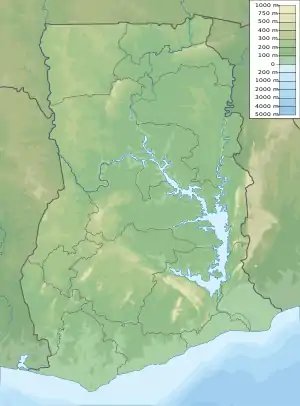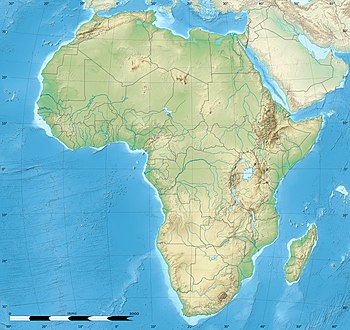| Muni-Pomadze Ramsar Site | |
|---|---|
 Muni-Pomadze Ramsar Location in Ghana  Muni-Pomadze Ramsar Location in Africa | |
| Location | Central Region of Ghana |
| Nearest city | Winneba |
| Coordinates | 5°20′40″N 0°39′01″W / 5.34444°N 0.65028°W |
| Established | 1992 |
The Muni-Pomadze Ramsar Site is in Winneba, Ghana. The Muni-Pomadze Ramsar site was designated as a Ramsar site in 1992 and it included two forest reserves which is the Yenku A and B forest Reserves.it also includes is the catchment of three seasonal streams, the Pratu, the Boaku and the Muni, which drain into Muni Lagoon. The lagoon surrounds the floor plain and the adjacent sand beach. which constitute the southern part of the site.[1]
Location
Muni-Pomadze Ramsar Site is situated to the west of the coastal town of Winneba, approximately 55 kilometers west of Accra. The Northern part of the site comprises two protected areas. Yenku A and B Forest reserves covering 10% of the site, while the traditional hunting areas of the Efutu people make up another 15%. The surface area of c.300 ha. According to report obtained, during the rains during the rains the lagoon fills up completely and spills over to flood the surrounding area about once every 10 years. Due to the rains, the villagers dig a canal to open an entrance to the sea and the excess water is released.[2] The catchment is a gentle undulating plain bordered to the north and the north-east by the Yenku Hills (290 m) and in the south-west by the Egyasimanku Hills (205 m). The hill-slopes facing the lagoon are fairly steep. The lagoon shoreline is covered with Sesuvium portulacastrum, Pabulum vaginatum and Bosporus virginicus, successively, up the sides of the dunes. The dunes themselves are planted with coconut-palm Cocos nucifera. The vegetation in the northern part of the wetland includes mangroves, with Typha australis, Ludwigia erecta and other typical freshwater hydrophytes occurring further inland. The vegetation in the upland areas is dominated by grassland and thickets, a Eucalyptus plantation, as well as forest vegetation in various stages of maturity.[3]
Restoring Our Mangroves Muni-Pomadze Ramsar Site
Members of the two fishing communities; Nsuakyir and Warabeba were inspired to restore degraded mangrove areas within the Muni-Pomadze Ramsar Site in Winneba, Central Region, Ghana. The Canadian Fund for Local Initiative (CFLI) funded for the mangrove seedlings (Rhizophora stylosa) which were planted at degraded sites at Muni Pomadze Ramsar site. During 2013-14, A Rocha Ghana worked with over 3,000 people from three adjacent communities to promote conservation and sustainable use of these mangrove resources.[4]
References
- ↑ "BirdLife Data Zone". datazone.birdlife.org. Retrieved 2019-05-18.
- ↑ "Muni-Pomadze Ramsar Site | Clearing House mechanism of Ghana". gh.chm-cbd.net. Retrieved 2019-05-18.
- ↑ "location" (PDF).
- ↑ "Restoring Our Mangroves Muni-Pomadze Ramsar Site". Ghana | A Rocha. 2016-12-21. Retrieved 2019-05-18.